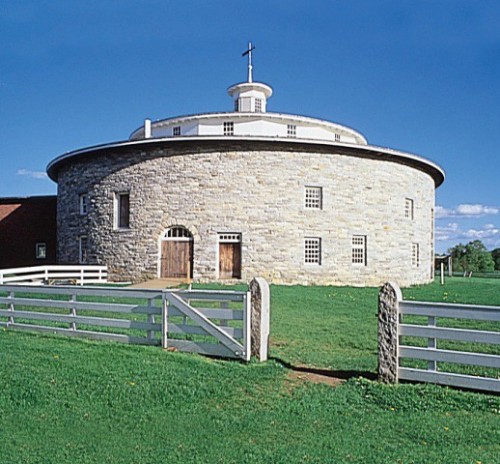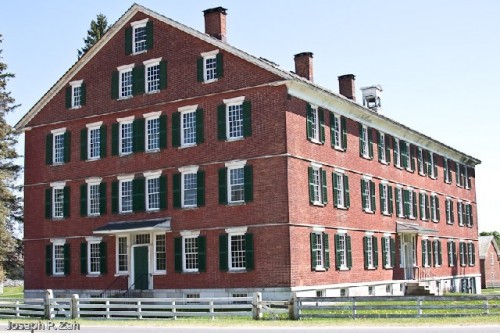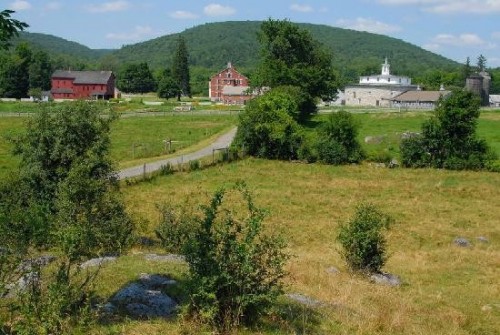Hancock Shaker Village Open House Dec. 11
Co Hosted With UMass Amherst
By: Shaker - Nov 30, 2010
Hancock Shaker Village (HSV) and UMass Amherst will host an open house for prospective students to learn about the new Master of Science in Design with a concentration in Historic Preservation program on Saturday, December 11 from noon to 2pm at Hancock Shaker Village (1843 W. Housatonic St., Pittsfield, MA). Please RSVP to Dr. Steven Bedford, program director, at 413.443.0188 ext. 239 or sbedford@hancockshakervillage.org.
The result of a three-year process of program development, curriculum refinement, and careful consideration, the new HSV-UMass collaborative graduate program utilizes the unique nature of the HSV site, which is a National Historic Landmark of over a dozen buildings in a pristine setting in Pittsfield, Mass. The program and facility will serve as a conservation and research center for Berkshire County, which is an area rich in resources, but poorly served by building conservation centers. “The setting is a wonderful teaching tool,” said Bedford. “If we want to illustrate a point, we just walk outside.”
The program kicked off this fall with an inaugural class of 13 students. The students come from a diverse range of backgrounds related to the building field, including an owner of historic home, a stonemason, a roof restoration expert, a landscape designer, and a quality control chemist. Lisa Westervelt, 48, of Cummington, Mass. is a heritage breed sheep farmer who also specializes in the craft of restoring historic decorative paint finishes. She was inspired to enroll in the graduate program because of its connection with Hancock Shaker Village. “I've spent the last 20 years in one way or another working on 18th and 19th century buildings and I thought that fine-tuning and expanding my education of materials conservation and period architecture would be interesting,” she said. Westervelt hopes the degree will allow her to offer more services in her restoration clients, as well as open up possibilities for teaching or working in a historic museum.
Hancock Shaker Village is a place not only to preserve the Shakers’ story, but to find meaning in the Shakers’ culture for our time. It is a center for reflection on living a principled life in the 21st century. The Shakers, at their essence, are ordinary people who made an extraordinary choice to gather together in community in order to live a principled life. The values that the Shakers embraced—equality, nonviolence, community, sustainability, responsible land stewardship, innovation, simplicity, embodiment of a spiritual ideal, and quality in work—still resonate today.
Engaging the compelling landscape of the Village, the faculty and the rich resources of the Commonwealth’s flagship campus as well as the wealth of diverse architectural resources available from Albany to Boston to New York, the innovative program in historic preservation and building conservation aims to encourage scholars and professionals to become active agents in engaging those ideals today by providing an opportunity to study Shaker building theory and method, as well historic craft and trade knowledge that went into making “the Principled Life” in the context of contemporary preservation theory, emerging technologies, and responsible public history practice.
The curriculum offers field, classroom, and laboratory experience for students in historic preservation in and beyond the museum setting. Students will gain exposure to traditional building techniques that are now hard to find and perfect. As the Village undertakes new conservation projects, the students have the opportunity to assist in building condition assessments and the development of preservation plans and historic structure reports, while watching the construction and construction management process in the museum’s ongoing conservation projects.
The course schedule, meeting on alternate weekends (Friday afternoons on the UMass campus through Saturday evening at HSV), is designed to provide traditional graduate students, working professionals, and career-changers the opportunity to receive training from practicing professionals who would otherwise not have the time to devote to teaching. At the same time, the faculty includes leading practitioners willing to spend weekends teaching in the country surrounded by great architecture.
The twelve-course curriculum is designed to be flexible enough for students to take one course at a time, or to follow the entire two-year curriculum. AIA continuing education credit certification is forthcoming.
In general, the curriculum follows well-established sequences. The first year introduces students to the basics of history, theory, and research. It also follows a year-long sequence of courses to help them understand the nature of 19th and 20th century building materials—how they perform and how they fail. Using the fully-equipped wood shop, the students learn traditional construction practices while they learn building history. The second year includes a year-long course in lab-based materials analysis and testing; courses in historic structural and MEP systems; and coursework advancing students’ understanding of how the buildings were used in the 19th and early 20th centuries from a material culture point of view and an exposure to the regulatory framework that supports the profession.
The program culminates in the team production of a historic structure report (HSR), giving them a product that serves as a condensed portfolio of their building conservation skills. The buildings at HSV provide excellent opportunities for creating HSRs, but we do intend to work outside the Village as well.




